Building regulations – compliance and enforcement: consultation analysis
Analysis of the building regulations compliance and enforcement consultation which ran between 11 November 2021 and 9 February 2022.
This document is part of a collection
3. High Risk Building Types
3.1 Domestic or residential buildings higher than 11 metres
1. The vast majority of respondents (83%) agree that a domestic building or residential building higher than 11 metres should be defined as a HRB. The strength of agreement is marginally stronger among organisations compared with individuals (Figure 3.1).
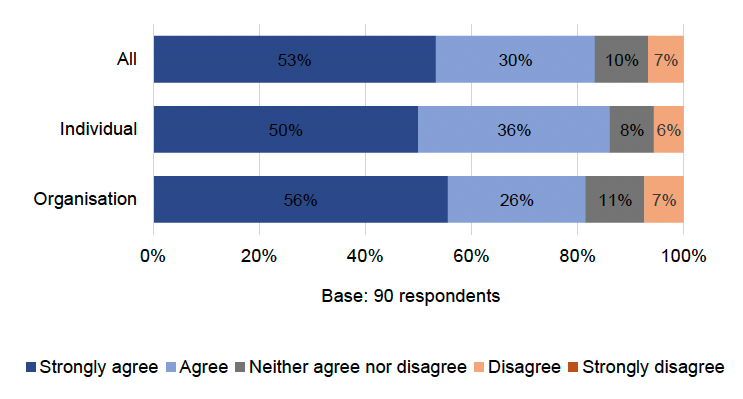
2. A total of 58 respondents provided reasons in response to this question. Many respondents (21, including 13 organisations) agree with the 11-metre proposal for fire safety reasons and given the importance of mitigating risks. This includes evacuation in the event of a fire, with lessons to be learned in wake of the tragic Grenfell Tower incident that remains in people's minds. It is therefore key to consider ease of access to the fire rescue services and the availability or reach of rescue equipment.
"Fires in purpose-built blocks of flats are more likely to experience firefighting delays than other dwelling types. A high-rise flat fire is over six times more likely to experience a delay to the start of firefighting because it takes time to assemble sufficient manpower and organise the support for the team attacking the fire. These delays increase the likelihood of fire spread, resulting in the need for evacuation, rescue, and the risk of casualties and fatalities, requiring still more resources, management and manpower." – Individual
3. Another risk mentioned by ten respondents is of a fire occurring at night, which adds to the difficulty instigating an evacuation at speed when people are sleeping.
4. A further 13 respondents agree with the proposed classification as they feel it will increase building standards and quality, and potentially alleviate or address workmanship issues that historically have been found in domestic and residential buildings.
5. They note that if these height-based parameters were to be used, a greater number of buildings would benefit from additional safety considerations (for example relating to fire safety and cladding) and with better consistency in design and construction and increased confidence among building users.
"This proposal will require a much greater number of residential buildings to meet the CPM requirements and ensure that more new build residential dwellings are built to a higher standard of quality control." – Organisation
6. However, whilst they fully agree with the HRB definition, 12 respondents believe that other building types should also be included within the definition for risk mitigation purposes. These include multi-tenanted buildings, hotels, student accommodation and hospitals.
"In determining the buildings which fall into the category of HRB, a risk factor approach may be more appropriate, instead of a 'yes' or 'no' tick box." – Organisation
7. Ten respondents neither agree nor disagree with the proposal, while six disagree. Across these groups 12 gave their reasons.
8. Among those neither agreeing nor disagreeing, five said they do not have enough information on the rationale of setting 11 metres as the threshold. One organisation added to this, noting that co-operative discussions should be held prior to a decision being made in order to encourage a consistent approach to applying the regulations across the UK.
9. Of the respondents disagreeing with the proposal, three stated that all buildings have the capacity to be high risk regardless of their height; furthermore that construction negligence is possible in all structures and if a CPM is put in place in the future, then the remit should cover all buildings and not just those over 11 metres high.
"This is a simplistic view of what it means to be high risk. For example, a shorter building that relies on several key components, say transfer beams, could be riskier than a taller building with a more robust form of construction. There needs to be a more nuanced approach developed." – Individual
3.2 Educational, community, sport and non-domestic public buildings under local authority control
1. Almost three quarters of respondents (74%) agree that educational establishments (schools, college and universities), community/sport centres and non-domestic public buildings under local authority control should be defined as a HRB. The strength of agreement is marginally stronger among organisations compared with individuals (Figure 3.2).
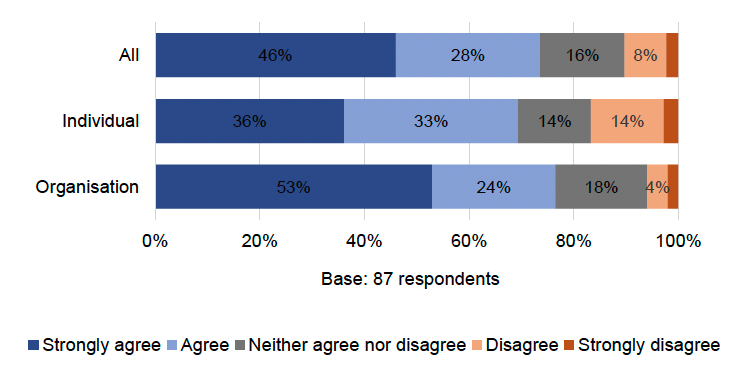
2. A total of 74 respondents provided reasons in response to this question. Many respondents who agree with this proposal (24) believe that due to the heavy use of these building types, they should be classed as high-risk. This is on the basis that they are often occupied to maximum capacity with members of the public, which can include young and/or vulnerable people. As such, these respondents feel that to safeguard the public from issues caused by non-compliance (notably fire risks), these buildings should be more stringently monitored and defined as HRBs.
"These buildings generally have a high occupancy with different types of users and as such all efforts should be made to ensure compliance during construction." – Organisation
3. Several respondents (15) note in addition to this that a greater level of scrutiny should be applied to such public building projects, pointing out that construction and compliance requirements are not currently as strict as for residential buildings.
"These building types don't often change hands/ownership and are prone to less scrutiny by independent parties compared to commercial buildings such as retail/commercial buildings. Therefore, these building types should be subject to a Compliance Plan to increase the level of scrutiny on construction workmanship and improve property protection." – Individual
4. A further eight respondents commented that educational establishments, community/sport centres and non-domestic public buildings are all greatly important to communities and the local economy, meaning that an incident such of a fire would have significant social and environmental impact.
"The loss of these buildings due to fire, structural or other damage causes significant, long-lasting damage to education provision, negatively impacts communities and causes environmental damage." – Organisation
5. However, six respondents, whilst agreeing with the HRB definition, raised additional considerations. These include:
- Smaller buildings that fall into these categories which have no public access could be excluded from the HRB classification (i.e. administrative offices);
- The buildings proposed should only be included if they are over 11 metres tall (and the HRB definition should apply to new builds, significant extensions and high value works); and
- Classifying such buildings as HRB may lead to unintended consequences, such as increases to insurance premiums.
6. Of the 14 respondents who neither agree nor disagree with the proposal, six mentioned a number of other considerations to potentially factor in. These include: the location of the buildings/facilities; building size; occupant numbers; specific risks within the existing buildings; whether or not buildings that are under 11 metres high (e.g. libraries) should fall under the HRB definition; and what the words "control" and "interest" mean in the context of these buildings, i.e. what would be the case if a public body was to lease an office in a building that would otherwise not be classed as an HRB.
7. A total of nine respondents explained their disagreement with the proposal, arguing that either the buildings suggested are not all high risk, or other parameters should be defined specific to these building types to delimit the classification.
3.3 Hospitals
1. Respondents were then asked if they agreed that hospitals should be defined as HRBs. Almost all (96%) agree, with the strength of agreement marginally stronger among organisations compared with individuals (Figure 3.3).
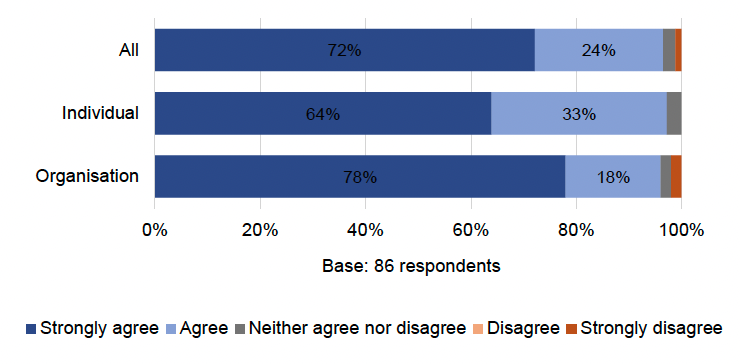
2. A total of 73 respondents provided reasons in response to this question. Many (25, including 17 organisations) note that hospitals typically have a high occupancy, including vulnerable members of the public with reduced mobility; furthermore that such buildings are visited by people unfamiliar with the structure and layout, which poses an additional risk in the event of an evacuation caused by a fire. These respondents argue that risk to life is significant, thereby establishing grounds for hospitals being classified as HRBs.
"[There is an] extremely high level of risk in the event of fire or collapse, where patients cannot be evacuated or could be seriously harmed if evacuation is necessary. Any evacuation would [therefore] need to be heavily controlled and could not be done safely or rapidly. The policy for all hospitals should be prevention, followed by early detection and rapid response to prevent major incidents from ever occurring." – Individual
3. Additionally, 19 respondents expressed concerns that the scale, bespoke designs and complexities of hospital structures and/or buildings means there is an increased level of risk for construction failures and non-compliance. They believe that classifying hospitals as HRBs would mitigate potential risks and address any workmanship issues within the build process.
"The scale and complexity of hospital projects, and the consequences of compliance failures in such facilities, means they must definitely be HRBs." – Organisation
4. Ten respondents furthered this point by noting the impact on communities and the local public would be severe if a hospital was lost due to fire. The wider community healthcare system would be harmed and the effect would be detrimental to many people reliant on care.
"Most hospitals provide a specific level of care or service provision which isn't replicated locally. The loss of a hospital, or part thereof [would] have wide-ranging consequences, particularly in more rural areas. Larger, single site hospitals provide services for a much larger community area and the loss again would be catastrophic." – Individual
5. Five respondents suggest expanding the definition of HRBs to include wider critical care facilities such as nursing homes, treatment centres etc.
"We support this additional assurance process within hospitals and believe that, due to the complexities of all NHS Buildings and our commitment to care for all staff and patients, the process should be applied to a broader range of health care buildings." – Organisation
6. Three respondents ambivalent to or against the proposal mentioned that healthcare buildings already undergo their own preventative risk mitigation for fire, and HRBs should therefore only comprise be high-rise buildings. This would mean not all hospitals falling under the category of high risk.
3.4 Residential care buildings
1. Again, almost all respondents (96%) agree that residential care buildings should be defined as HRBs. The strength of agreement is marginally stronger among organisations compared with individuals (Figure 3.4).
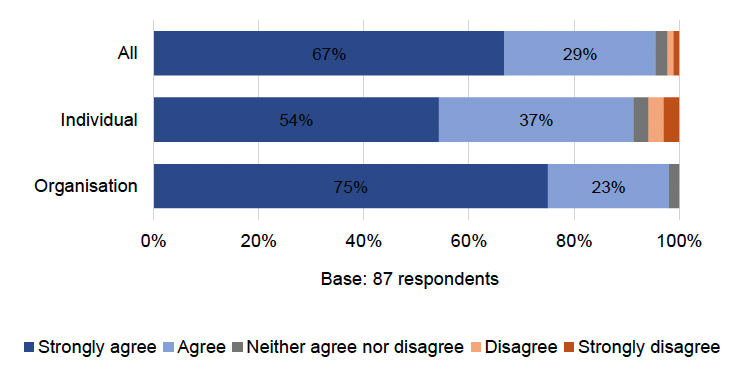
2. A total of 71 respondents provided reasons in response to this question. Fifteen respondents made the point that residential care buildings are often exclusively occupied by vulnerable people with limited mobility. In the event of an incident or disaster, these individuals would not be able to easily self-evacuate.
"By their very nature, these facilities house people who are vulnerable… therefore strong fire safety measures are essential. As such the design and construction of these residential care buildings should be a matter of [utmost] scrutiny." – Organisation
3. Ten respondents (including eight individuals) emphasised that residential care buildings and nursing homes are vital to communities and should be closely protected. One respondent believes that the community impact if a facility was lost (i.e. due to a disaster or fire) would be significant. Furthermore, since care homes are a finite resource and often at maximum capacity, there would be little room for patient overspill elsewhere.
"These high-risk buildings are particularly vulnerable due to their function and the make-up of their occupation, particularly with respect to occupants' limited ability to self-evacuate in the event of a fire. Furthermore, in addition to life safety considerations, the loss of these buildings due to fire, structural or other damage causes significant, long-lasting damage to the health and well-being of our communities." – Organisation
4. Some respondents (15) made the point that due to their complex structures, it is essential to ensure construction and workmanship on these buildings are to a high standard in order to mitigate errors and negligence.
"Given the additional regulation and fire safety measures residential care buildings require, it would seem right to categorise them as high risk. The additional detailing and measures within their construction are deserving of heightened compliance checks." – Organisation
5. However, ten respondents who agree with the HRB classification for residential care buildings mentioned additional considerations. They suggest that such buildings are not in themselves as high risk as hospitals, and that the HRB definition should consider such factors as those which are above 11 metres, new builds, high value works, buildings with high resident numbers or significant extensions.
6. One respondent notes that the definition of "care building" is ambiguous and would need to be more specific, while an organisation recommends that other types of institutional residential buildings (e.g. prisons, psychiatric facilities etc.) should be included within the definition.
"Low rise, single storey buildings with good evacuation routes and more able bodied residents may find this an excessive requirement." – Individual
7. Of the respondents who did not agree with the HRB classification for residential care buildings, one individual notes that it is dependent on how much usage the building has, as to what level of risk is involved.
3.5 Low-rise volume house building sites
1. Views are divided as to whether low-rise volume house building sites should be defined as a HRB, with 36% agreeing, 39% neither agreeing nor disagreeing, and 24% disagreeing. The mix is similar between individual and organisational respondents (Figure 3.5).
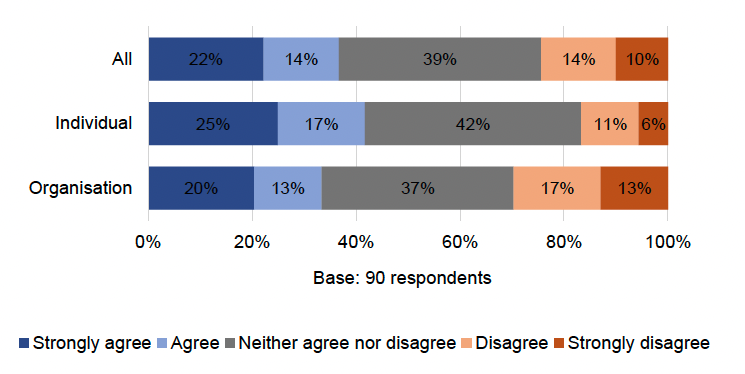
2. A total of 75 respondents provided reasons in response to this question.
3. Ten respondents believe that many low-rise volume house building sites are prone to health and safety risks and should be classed as HRBs. They note a history of non-compliance and failure to meet certain installation or build standards; furthermore two individuals suggest that measures put in place by the National House Building Council (NHBC) are not adequate due to existing longstanding issues with quality and performance.
"The self-governing NHBC is a failed scheme and a commercial entity making decisions on compliance is wrong. Evidence proves quality in compliance is not in the most part adhered to, and the last 50 years have seen a decline in long term good quality domestic build by volume builders." – Individual
4. Nine respondents raised concerns about the environmental impact of these sites due to the high quantity of buildings and that an increased level of compliance management would be beneficial for climate control.
"There is a strong public interest in new build housing with a particular focus on climate change. Anything that strengthens compliance in this area should be adopted for this building type." – Organisation
5. Alongside these concerns, eight respondents explained that these buildings may be occupied by vulnerable members of the public; that house fires are potentially just as dangerous as flat fires; and that the risks should be mitigated as a matter of public safeguarding.
"We would further note that whilst there are usually fewer risks to life on low rise residential developments, there have been significant fires on 3-4 story flatted developments and therefore suggest that regard needs to be given to how to minimise the risk to occupants." – Organisation
6. Five respondents suggest that all new and future builds be regulated to the same level of compliance as HRBs, in order to alleviate the risks in all areas regarding public safety and the environment.
"As high-volume housing is a substantial part of the Scottish built environment, it is essential that all new builds are in accordance with the Building Regulations to give the government assurance they are meeting their net zero targets." – Individual
7. Among respondents neither agreeing nor disagreeing with the proposal, 13 said that whilst in theory the additional compliance measures brought about by the HRB classification would be beneficial, the level of risk would greatly depend on the type of building. They believe that the risk associated with these buildings is low and therefore less significant, but it may vary if (for example): buildings are private or publicly owned; the quantity of buildings within the site is large; the buildings are high or low-rise; and, most notably, if the buildings are multi-tenanted or single occupancy.
"Low rise buildings, by their nature, may be less risky due to the lower height but surely we should consider the risk profile of all buildings; less complex buildings will obviously have less risk, but the environment, master planning, ownership and occupancy will all have an impact on the risk profile." – Individual
8. Five respondents believe that the CPM role would be beneficial to all building types, but are concerned about inadequate levels of resources and a very limited number of qualified individuals to complete the assessments. The inclusion of low-rise volume house building sites in the HRB definition could therefore create too much additional work for the resources at hand, and they note that such buildings are not a high enough risk to be given priority.
"Including this building type in a high risk category would certainly also present a huge resource issue to many local authority verifiers in being able to deliver the heightened number of site compliance checks that would be required." – Organisation
9. Six respondents feel that an adequate level of compliance is already in place, with mechanisms, site agents and existing onsite quality control processes ensuring building standards are achieved. However, they note that these current measures could be strengthened through the inclusion of a CPM.
10. Of respondents disagreeing or strongly disagreeing with the proposal, six argued that there are already appropriate levels of compliance checking; furthermore the majority of volume house builders already employ independent inspection regimes through NHBC or other insurance/warranty providers.
11. Ten respondents stated that the risk associated with these building types is minimal and needn't therefore be defined as high-risk. Some went on to say that additional costs would be incurred which would be detrimental to the overall compliance process.
"Low rise residential buildings are of a lesser risk class under the guidelines and this should be maintained. Applying HRB status to these buildings would be a negative approach and may needlessly affect costs." – Individual
3.6 Building types requiring a strengthened Compliance Plan regime and CPM
1 The majority of respondents (86%) agree that where a building falls into one of the defined HRB categories either by conversion or where an existing HRB is being altered or extended, that these building types should follow a strengthened Compliance Plan regime and require a CPM to be appointed. The strength of agreement is similar between organisations and individuals (Figure 3.6).
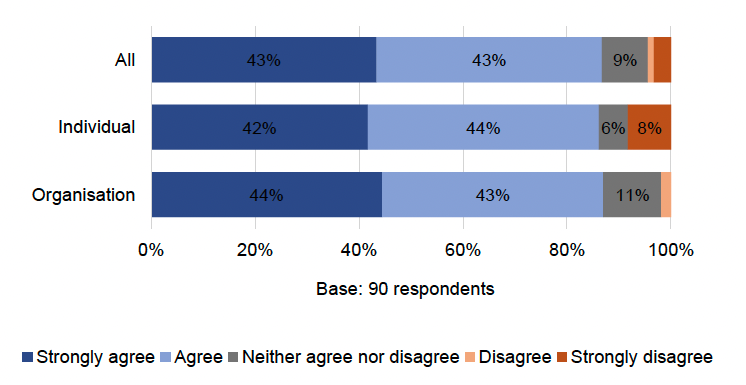
2. A total of 78 respondents provided reasons in response to this question. Several (23) believe that the process of a large conversion or alteration introduces a significant risk to a building and, as such, should be treated as comparable to the risks associated with new builds. This is believed to be especially the case if the work done is complex, causes the building to become part of a higher risk category or requires a building warrant.
3. A further five respondents note that in appointing a CPM, it may prevent buildings undergoing substantial alterations or conversions that could present unnecessary new risks.
"Conversion of existing buildings into a higher risk category can prove more difficult to ensure compliance than in the case of a new build. For this reason, it is important that conversions, alterations and extensions are included in the HRB category." – Organisation
4. Added to this, three respondents mentioned that older and less thermally efficient buildings have a far greater impact on the environment than new builds, so in the case of conversion or alteration, there is an increased climate risk in the event of non-compliance.
5. Twelve respondents caveat their support on the basis that consideration should be given to the scale and complexity of a build. For example, there may be some minor, low risk works without building warrant requirements that would not need a CPM. The introduction of a CPM process in these cases therefore has the potential to add additional burdens, such as increased insurance premiums or stretched CPM resources with very little beneficial returns. They suggest that more specific criteria be put in place based upon the scale, complexity and risk characteristics of the alteration or conversion project.
"We would support the introduction of the CPM regime in all HRB categories, however consideration should be given to the scale of development that the proposed CPM process would be applied to, as it could introduce additional burdens with limited benefits if not applied on an appropriate and proportionate basis." – Organisation
6. Of respondents neither agreeing nor disagreeing, four share the view that the application of a CPM or compliance plan regime should be dependent on the type of build, and that consideration could be reasonably given to the estimated value of works, floor areas, if any escape routes are altered, as well as cladding alterations.
7. Three respondents are of the opinion that the CPM process would be unnecessary for minor building changes and that there should be greater clarification on the level of work that would trigger the need for the compliance plan. One organisation pointed out that minor changes are commonplace, with many unlikely to need the actions prescribed to the CPM.
8. Among four respondents disagreeing or strongly disagreeing with the compliance plan and CPM proposal, two referred to existing building standards mechanisms as being adequate enough to deal with any alterations within the bounds of existing legislation.
Contact
Email: thomson.dyer@gov.scot
There is a problem
Thanks for your feedback